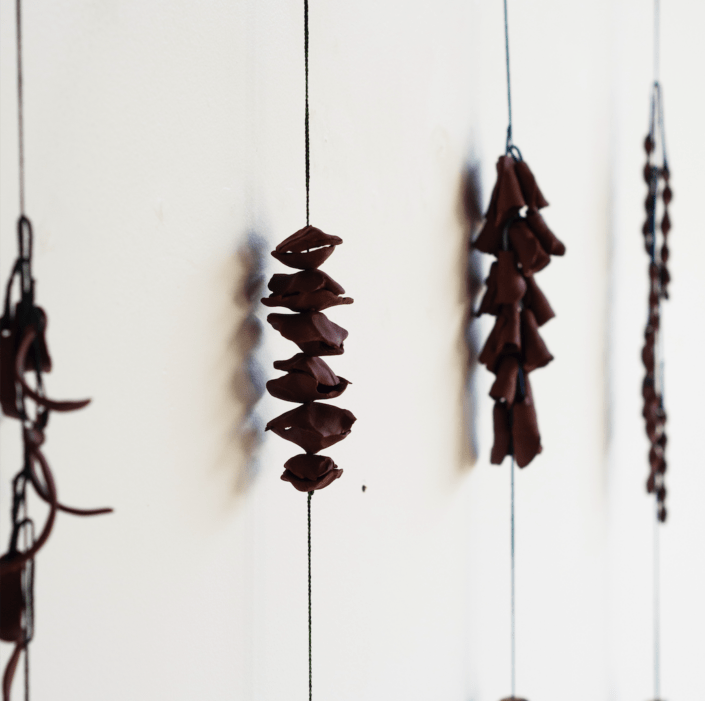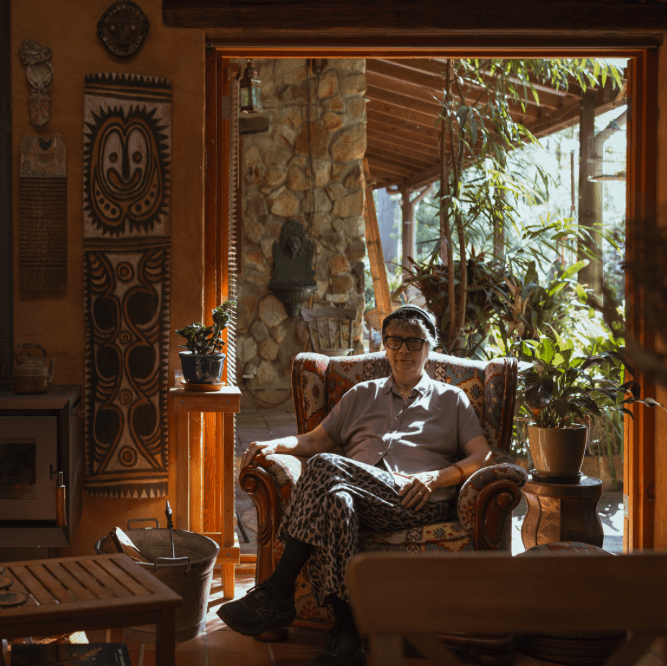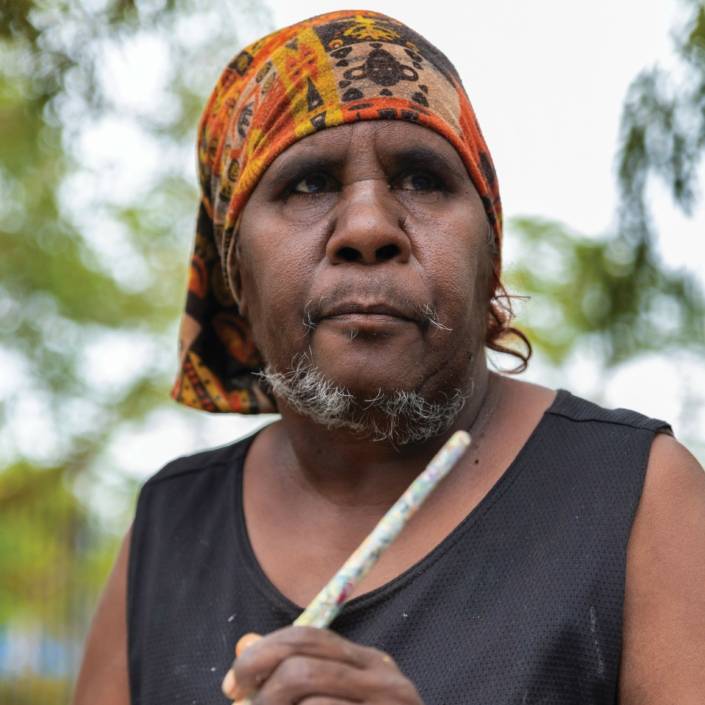Linda Marrinon: Sense and Sensibility
For four decades, Linda Marrinon has practiced with distinguished earnestness and humility.
Words: Jacqueline Millner
Photography: Elke Meitzel
A comic-book female Jesus struggling under the cross of prejudice and misunderstanding (What I Must Bear, 1982). An apology for a painting (Sorry, 1982). A rock in underpants (Rock with Underpants, 1992). These are some of the early gestures that ensconced Linda Marrinon in the canon of Australian contemporary art as an artist whose sensibility captured the zeitgeist of ironic wit and bemused social critique. Rising to prominence in the early 1980s very soon after graduating from painting at the Victorian College of the Arts, Marrinon was picked for the cover of the arch postmodern art magazine, Art and Text, with I sailed to Tahiti with an All Girl Crew, 1982 a piece that mixed her love of pop cultural forms, playful anti-heroic mark-making and feminist knowingness. As art historian Chris McAuliffe wrote in his 2007 monograph, Marrinon’s “cheeky, immediate, cartoon-like” work appealed to critics and curators keen to escape the intellectualism of conceptual art as much as the formal strictures of abstraction, and ready to embrace the artistic equivalents of post-punk. Her “idiosyncratic meld of bad painting and deft cartooning, wry art historical references and high theory… had all the power of an idea whose time had come,” he wrote.
But unlike much art from this high-water mark of postmodernism, Marrinon’s always retained elements of genuine emotion: pleasure in the making process, warmth towards her sources of inspiration including art history, and empathy for her often vulnerable and hapless subjects (including herself). And it is this distinguishing earnestness and humility that drove the artist’s continuing experimentation with styles and media. For, after her early success with “bad painting”, Marrinon radically changed tack to embark on a quest to be good at sculpture, and 19th century sculpture no less.
Marrinon’s earlier sculptural works, such as Rock with underpants, 1992, transformed found objects with feminist wit. But the artist then committed to retrain in traditional skills, investigating French 19th century sculpture in graduate research before undertaking further technical training at New York’s Academy of Art. The novel formal language that emerged from this trajectory took Marrinon into the generative realms of terracotta, plaster and bronze, propped up by proper armature, and allowed her to effectively grant a new lease of life for the genre of figurative sculpture.
Marrinon’s sculptures are for the most part domestic in scale and value: comfortable on a mantlepiece, figurative and decorative, softly coloured terracotta or plaster. But she brings to her subjects – often types derived from art historical or pop cultural sources – that balance of humorous impudence and empathy that marked her earlier practice. This sensibility comes through in the (often cartoon-like) evocation rather than refined resolution of particular features – such as facial characteristics or details of dress – together with a deliberate lack of finish that suspends the figure in a state of mutability, still open to the artist’s whim.
The works’ material lushness and delicate palettes render them sensually appealing while their art historical erudition and technical aplomb place them in a familiar continuum of neo-classical aesthetics. To this, Marrinon adds contemporary twists, at times seemingly incongruous elements such as state of the art technologies or fashions, that trigger bemused recognition in the viewer.
In Pierre Fresnay and other sculptures, her latest show at her long-term commercial gallery Roslyn Oxley9, Sydney, Marrinon showcases all these aspects of her work. The joy of the process of making and delight in materials are evident in the loose evocations of place in crumbling pastel forms that pique the appetite like cakes left out in the rain: Mist at Cootamundra, and Visitors at Little Petra (tinted plaster and hessian), both 2022, for example. Her simultaneous honouring and lampooning of the Western sculpture tradition are embodied in the terracotta renderings of Portrait of Hera with woman with stole, 2021 and Woman with Hobble Skirt, 2023 that capture the tradition’s idealising of the female form but overlaid with Marrinon’s feminist wit and postmodernist scepticism.
The love of popular culture, including some more obscure references that also reflect the artist’s Francophilia, is there in the painted plaster homages to Pierre Fresnay (Pierre Fresnay (orange) and Pierre Fresnay (blue), both 2023) in military uniform: Fresnay was a French theatre and matinee idol of the 1920s and 30s, whose debonaire qualities were further exalted by his distinguished military service. In Marrinon’s hands, well-tried at skewering masculinist pretentions, Fresnay strikes an affable pose, less the intimidating star and soldier than an approachable bloke.
Not long before this coming exhibition, Marrinon installed her first large-scale public sculpture in the gardens of the National Gallery of Australia. Woman in Jumpsuit, 2021 is a scaled-up version of Marrinon’s signature mantlepiece figures, and, although cast in coloured bronze, is hand-painted in yellow and pink to recall her preferred soft and fragile materials.
The commissioned statue is slated to remain on site for a year, its self-effacing aesthetics delightfully at odds with the usual pomposity of public sculptures that have in recent years been taken to task by decolonising iconoclasm. That its fate beyond that remains unclear would seem of a piece with the artist’s sensibilities.
In 2018, Marrinon was awarded the Don Macfarlane prize for her contribution to Australian art, a prize for which one does not apply but is selected by their peers. Marrinon was cited for her commitment to studio craft and art history, for her ability to seamlessly navigate high and low culture, the serious and the funny, and her courage in changing direction and relearning her craft. These qualities remain palpable in her current work, where self-reflective flashes of insight into the human condition are delivered with gentle humour, materially rich aesthetics and an impressive art historical range.
ELSPETH PITT
Senior Curator, Australian Art, National Gallery, Canberra
“Linda Marrinon is one of those artists I feel I’ve always been conscious of – her work is so distinctive. Different works have stayed with me over time. Seeing the painting Colin Gamlin, 1986 in a private collection was a revelation. Woman of Albert, France, in The National 2019 had such a quiet, concerted power. I remember walking into her Museum of Contemporary Art, Sydney artist room presentation in 2016 – it had such beauty and lightness, but there was also strangeness. There is sometimes in her sculpture a real sense of alienation or loneliness.
I like that the works are so contained, so poised. And yet they traverse time. Linda is just as likely to portray Germaine Greer as a Gibson Girl. There is also in her work a material tension. Her sculptures are so delicate, as though they might crumble to the touch. But they can also seem like relics, resilient in spite of their delicacy. They’re also unerringly beautiful, which is rare.
Linda’s sculpture has often focussed on the portrayal of women – named, unnamed, imagined. In that regard, her practice is often described as feminist. My feeling, however, is that her work is not motivated by singular or strident political concerns. Linda seems to me to be a very nuanced artist and intellect.
That’s what I love about Linda’s work, the reference points are so diverse – pop bands, feminist icons, historical fragments and vagaries summoned into sculpture. It’s an explorative practice. It’s so particular in its style and manner of making, but it’s also capable of broad appeal.”
ROSLYN OXLEY
Director Roslyn Oxley9 Gallery, Sydney
“Linda has been represented by Roslyn Oxley9 Gallery for more than 40 years. We presented a group of oil paintings by Linda in a group exhibition in 1983 entitled Pirates and Mutineers. Her paintings were very funny and often a wry take on feminism. In the same year, Judy Annear included Linda’s work in the 1983 Australian Perspecta at the Art Gallery of New South Wales which really caught my attention. [I am drawn to] the madness of it all! Her sculptures are always full of feeling and expression and sometimes very humorous. You never know what is going on in their heads. The expressions on their faces are uncanny and very human, but at the same time indistinguishable in many ways. Marrinon has been exhibiting since the early 1980s when she came to prominence for her satirical paintings and drawings that combined art history and pop culture. Today, she is better known for her modestly scaled figures and busts that fuse techniques associated with 19th century figurative sculpture with a contemporary sensibility.
Linda is always working. She is always ready if I call her up and ask her to do a show and, as a result, we sell her sculptures very steadily and consistently. If they are out on display at the gallery, we sell them.”
This article was originally published in Art Collector issue 104, April-June 2023.









